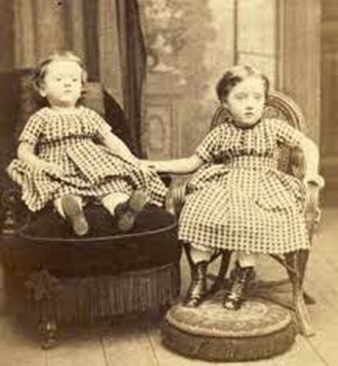Have you ever looked at a Victorian photograph and thought that the pose of the sitter was somehow unnaturally stiff? Exposure times were slightly longer then, so sometimes the sitter was helped to keep their pose with a sort of clamp. Some sitters were, however, stiff, being dead. The Victorians were adept at photographing the dearly departed. Post-mortem photographs were sometimes referred to as mirrors with memories.
The Victorians were prudish in so many respects (there was a society campaigning for horses to be made to wear trousers, good luck with that,) yet seemed to release all their pent-up inhibitions around death. The new art of photography gave them a further way to mourn, with the deceased being photographed, often for the first time in their life (or death,) in their bed, their coffin or, in some cases, propped up with their still living siblings. There are instances of a live mother covered with a cloth, like a canary in a cage, holding her deceased child, to just showcase the baby.
A mourning tableau could be created, with the deceased tastefully displayed, in as lifelike a pose as their present condition would allow. Around them would be perhaps other family members, pet dogs, a favourite toy. Everything had to be arranged with some celerity, before the process of decay set in. The title of this article reflects that necessity; it was often used as a marketing slogan by photographers specialising in this rather ‘specialised’ art form.
It is sometimes claimed that the deceased subject was held in place by an iron clamp, because exposure times were supposedly so much longer than now. This is a fallacy. Certainly, the early landscape photographs, created using a camera obscura, needed an exposure time of about 30 minutes, but this was never used to photograph people. The daguerrotype, invented in 1839, shortened this to about 90 seconds. By the middle of the century this was typically no more than 10 seconds. This time still allows a subject to move slightly, causing the finished picture to be blurred. The stands, usually iron and weighing perhaps 20 pounds, were an aid to stillness. They were not counter-balanced, so could never have withstood the weight of a corpse without falling over. It’s interesting to realise that the photograph of a live sitter may well have been less clear than that of the deceased – the latter would naturally remain perfectly still.
The photographs, a form of memento mori, could be very ghoulish. Open eyes were sometimes painted onto eyelids that were now closed forever. A deceased child in a row with its siblings might be left with the pallor of death, whilst the cheeks of the quick would be rosily tinted. For those whose end was not as peaceful as one might hope, there was little in the way of post-mortem reconstruction. We can see photographs with evidence of severe injury or burns or disfiguring diseases such as lupus.
For those hardier types, there was a process where the eyes could be reopened. It had to be carried out very soon after death, or the tache noire effect became all too apparent – the cornea dries out and becomes a colour ranging from orange to black. In 1873 the photographer Charlie Orr wrote that the thought of opening the eyes may be a little daunting, but, “this you can handily effect by using the handle of a teaspoon”. One post-mortem photographer gave this advice, to help prepare for the session. “If a person has died and friends are afraid that there will be a liquid ejected from the mouth, you can carefully turn them over just as though they were under the operation of an emetic. You can do that in less than a single minute, and every single thing will pass out, and you can wipe out the mouth and wash off the face and handle them just as well as if they were well persons.”
The advent of cheaper, easier to use cameras and the ‘snapshot’ sounded the death knell for post-mortem photography. Why just photograph the dead for posterity when you could get them full of vigour? It is very unlikely that the heightened sensitivities of the 21st century would welcome such a last reminder of the dearly departed. Neither would those who feel threatened or intimidated by, for example, the words of long dead authors be able to make the necessary preparations. Now death is the great taboo, to be covered up and sanitised. Horses, on the other hand, can roam unclothed without let or hindrance.
Image Credits: Michael Montagu .



